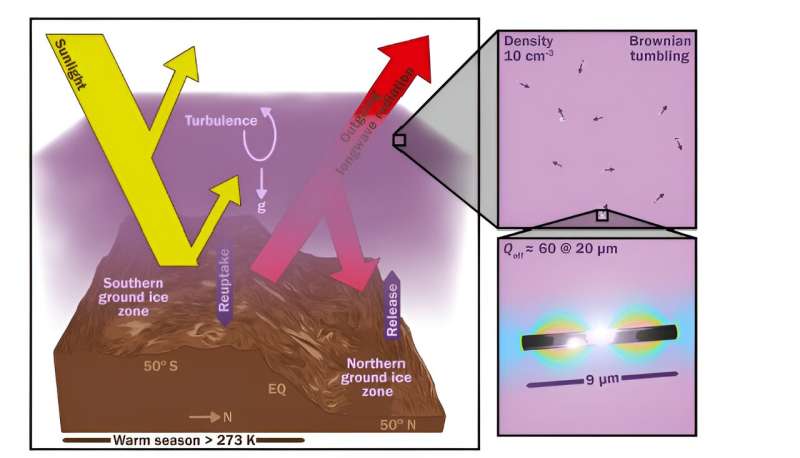August 8, 2024 report
This article has been reviewed according to Science X's editorial process and policies. Editors have highlighted the following attributes while ensuring the content's credibility:
fact-checked
peer-reviewed publication
trusted source
proofread
Model suggests spewing metal nanorods into Mars' atmosphere could warm the planet by 30 K

A small team of engineers and geophysicists from Northwestern University, the University of Chicago, and the University of Central Florida has found, via modeling, that creating millions of metal nanorods from material on the Martian surface and then blasting them into the atmosphere would be a more efficient way to heat the planet than generating greenhouse gases. Their paper is published in the journal Science Advances.
Science fiction writers have for many years envisioned a future when Mars is made habitable through terraforming techniques, allowing humans to survive without the need for special buildings and spacesuits. Recently, scientists have begun looking at the possibility, though most project ideas are far less ambitious.
Instead of completely transforming the planet, many are looking at simply warming it up a bit to make it more habitable. Most such ideas have centered on releasing greenhouse gases into the atmosphere to capture more heat from the sun. Unfortunately, there are few ingredients on the Martian surface that could be used to create and release such gases.
In this new effort, the research team suggests an alternative method—releasing millions of metal nanorods into the atmosphere.
Metal nanorods, the researchers suggest, could trap heat in much the same way that Martian dust does but would remain in the atmosphere longer. They compare the effort to shooting glitter into the atmosphere. They state that nanorods could be easily made with materials on the Martian surface, and presumably be reused once they fall to the ground. Initial testing showed the nanorods would settle 10 times more slowly than dust.
To find out if their idea is feasible, the researchers used the MarsWRF global climate model, along with an additional 1-D model to mimic the conditions they sought. After including data describing the addition of metal nanorods into the atmosphere, they ran the model to see what would happen.
The model showed that if the nanorods were fired at 30 liters per second into the atmosphere, the entire planet would warm by 30 K (which is equivalent to 30°C or 54°F). It further showed that if the firing were sustained for at least 10 years, ice on the surface would start to melt.
The research team suggests the use of metal nanorods to warm Mars would be far more efficient than trying to do so with greenhouse gases.
More information: Samaneh Ansari et al, Feasibility of keeping Mars warm with nanoparticles, Science Advances (2024). DOI: 10.1126/sciadv.adn4650
Journal information: Science Advances
© 2024 Science X Network





















